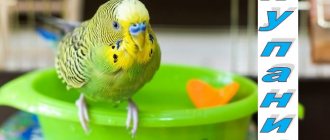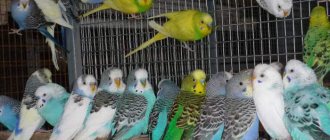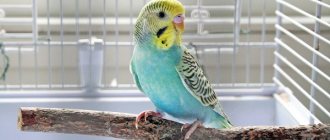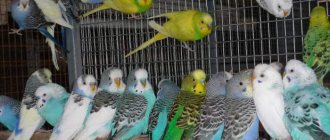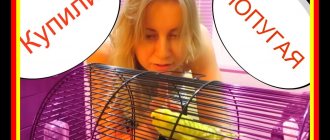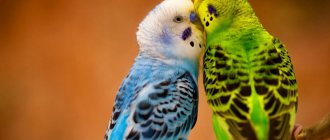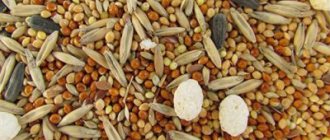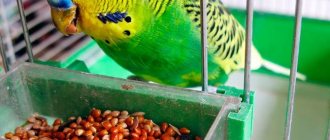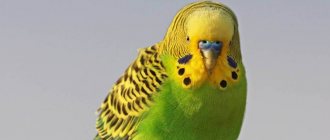How many parrots to buy
The number of birds depends on the goals and capabilities of the breeder.
If you are choosing a companion who will brighten up your loneliness, it is better to take one talking parrot. Constant communication and care will allow the new pet to become a full member of the family over time. Connoisseurs of silence are advised to get a girl budgerigar, since females are less noisy than males. If the owners are not home much, the lonely bird begins to feel sad. You can save your feathered ward from sadness by choosing company for him. Two or three individuals can live in one spacious cage. Well, if you have plans for breeding, buy a female and a male at once.
Selection rules
Many people think that the bird suffers alone because it lacks communication. But if the parrot is given a lot of attention, then it feels great and also quickly learns to speak. If the parrot remains alone throughout the day, then it is advisable to find a mate for it.
It is advisable to initially buy budgies in pairs, and also choose a mate for the bird after it learns to speak.
In order to choose the right pair for a male or female budgie, you need to take into account the following factors:
if you plan to breed birds in the future, then it is advisable to choose parrots with the same color;- the male must be older than the female, and the difference must be from 2 to 4 years, otherwise the female will dominate;
- It is recommended to choose a large male, otherwise the female may peck him during the mating season;
- before purchasing, the bird’s temperament is assessed, since its character must match the existing parrot;
- At the time of acquaintance, it is desirable that the male is sexually mature and the female is about 4 months old, since an adult bird can show aggression and dominate.
During the adaptation period, it is important to create a calm atmosphere, and a spacious cage with a house is also purchased.
If you purchase birds with different colors, this often leads to the appearance of sick offspring. It is forbidden to mate closely related parrots, as the resulting chicks are underdeveloped.
How many parrots do you have?
12
How to teach to talk
It is clear that if you do not work with the wavy, he himself will never learn to imitate human speech. You need to learn conversation from an early age, but not immediately after purchase. Be sure to give the bird time to adapt. Depending on the nature of the bird, this could be a week, two or even three. In any case, there is no need to rush.
You need to start teaching your parrot words only after he gets used to you - he will not run deeper into the cage when you approach, he will boldly sit on your finger, take food from your hands, etc. Initially, you need to teach the simplest and shortest words that need to be repeated regularly when performing some action. For example, when pouring food, you can say “Eat”, changing the water - “Water” or “Drink”, etc. If you want to teach your parrot long phrases, record them on a voice recorder and play them back to your parrot.
It is important that it is better to do this in the twilight, because if the bird sees poorly, they begin to concentrate on sounds. It has been noticed that budgies perceive high-pitched voices better, for example, women's voices.
Now you know how to choose a parrot for your home so that it can start talking. It's not as difficult as it might seem at first glance.
Common mistakes
A voice recorder will only do harm during the learning process. Common mistakes in training budgies include:
- Frequent use of voice recording.
- The use of ill-conceived phrases or phrases.
- Application of specific terms.
- Frequent changes in intonation, tone or rhythm.
The gravest mistake is to use harshness, violence or intolerance. You should not raise your voice at the bird, scare it with sudden movements, or try to grab it with your hand.
Habits and character of the male, in contrast to the female
Observing pets at home, you can notice behavior patterns that directly or indirectly indicate the sex of the birds. How can you tell a boy's parrot from a girl's parrot if you look closely at their habits?
The male is nimble, restless, talkative. If you hang a mirror in a cage, the boy will show off in front of his reflection and try to bully his imaginary opponent. Even the songs of budgerigars are different: in the male they are loud, complex, and drawn-out. During his walk, he flies a lot and explores every corner with interest. Emphasizes its dominant position, puts its paw on its cage neighbor. The boy parrot is more successful in mastering human speech; his onomatopoeia is better developed.
The female with a wavy pattern can be distinguished by her modest manners; she is quiet and economical - she likes to clean up the cage. She chirps more than sings, her voice is expressionless. There is almost no ability to learn, the cases of pronouncing words are very rare. In communication with a person he does not show initiative, but in his hands he behaves quietly. The released bird, after flying for a bit, takes an observation position.
Shyness and submissiveness do not guarantee that you will accurately know the gender of a parrot. Not all females have a balanced character. There are individuals that are distinguished by jealousy and aggression. They constantly quarrel with their neighbors, mostly female.
Indicators of a healthy bird
Whatever parrot you choose, the main thing is that it is healthy. But a boy or a girl, a chick or an adult is not so important. We are not talking now about those people whose main feature is volunteering.
Choosing a healthy parrot
They welcome everyone: a sick cat, a lame dog, a crow with a broken wing, an old hedgehog who wandered into the countryside in search of food... Exotic birds are no exception.
An ordinary person cannot withstand such stress. Treating animals is very difficult, expensive, and requires enormous emotional investment. It's okay to choose healthy ones. What to look for when choosing?
Beautiful plumage
Turquoise, white, yellow, green birds with wavy dark stripes on the back, wings and neck (for which they got their name) should be shiny, bright, with feathers tightly fitting to the body.
Clean nostrils and beak
Neither on the beak nor on the cere of a healthy young bird there is peeling, separation, or even discharge.
One of the indicators of a healthy parrot is clean nostrils and beak
Quiet breathing
No overtones, and even breathing itself should not be heard. You can feel it by holding the wavy in your hands.
Proportional beak
The nose is straight, exactly in the center, the wax is located symmetrically.
Number of fingers
Be sure to check your paws! Injured limbs in these birds may not just hurt. The damaged finger may dry out and die (fall off). No growths, abrasions or bruises. The limbs are even in color, covered with feathers, tenacious.
Clean cesspool
Carefully examine the tail and what is underneath it. If your parrot has gastrointestinal problems, it will be noticeable. Sometimes the anus is occupied by scabies mites. It is advisable to detect the presence of parasites or insects before purchasing.
Check the cleanliness of the cloaca
Sociable behavior
The wavy is a mobile creature. If he is apathetic, looks sleepy, or is offended by his relatives, it is better to take another one. But not the one that rushes around the cage like a madman, bumping into objects. These are the first signs of ill health. The bird should be cheerful, all its movements should be coordinated.
Read also
What time does a budgie go to bed?
How to determine the sex of rosella, necklace, and gray parrots
Parrots of the genus Gray, Rosella and necklace representatives are also chosen for home keeping. These birds have characteristic appearance features that can be used to determine their gender.
The main differences between females and males:
- By the age of 2-3 years, male parrots with necklaces develop a black rim around their necks, resembling a necklace. Girls do not have such decoration.
- Male African Gray parrots have a large body, a small flat head and a short neck. Girls are slimmer, have a rounded head, and a long neck. Males have a more uniform and darker color. Females have gray belly feathers.
- Boys of the genus Rosella have a sloping nape and a massive beak at the base. Females have a round head and light stripes on the inside of their wings.
The most accurate answer to determining the sex of a parrot will be shown by a DNA test. The study is carried out in laboratory conditions. The owner must provide a plucked feather for analysis (feathers that fall out are not suitable for testing). Such an analysis is quite expensive, but it shows a 100% reliable result.
Regardless of gender, parrots in the house need to be provided with comfortable conditions and a healthy diet for health and longevity. In our store you can buy high-quality food for different types of parrots, healthy supplements with vitamin and mineral complexes, cozy cages for birds to live in, feeders, drinkers, perches, various toys and other accessories for a comfortable and healthy life for your feathered friend!
Choice of talking wavy
If you're wondering how to choose a talking budgie, here are our top tips.
- The easiest thing is not to buy a talking parrot, but to teach it to speak on its own. Therefore, the question should rather be how to choose a budgerigar so that it speaks.
- You need to start training your parrot as early as possible; green males, according to statistics, learn human speech skills easier and faster. White birds, on the contrary, are least likely to have such abilities.
- There is an opinion that you need to choose the weakest chick in the brood, go out and tame it. It is such a bird that will recognize its owner as its leader and will begin to obey him.
- The most optimal age when a bird is able to start talking is about 7-8 months. It is better to start learning with words with hissing sounds.
Thus, to the question of how to choose a budgerigar to speak, the answer is this: you need to choose a young male parrot, while all the signs of an active, healthy bird should not raise even a shadow of doubt.
Feather imitators
Based on numerous films and cartoons, as well as historical facts, you can verify that budgies actively talk to their owners.
Although, to be more precise, the term “talking” is not correct. In fact, birds only reproduce the sounds that humans make, that is, they become imitators.
Since a feathered pet does not have human thinking, it cannot conduct a conscious dialogue or answer a specific question. But teaching him some words related to the situation is quite possible. Budgerigars are quite smart birds that can string several words into a sentence and even recite a poem, and the quality of pronunciation will be at a decent level.
How to distinguish from a photo
Parrot sellers insist on keeping track of the differences between a boy and a girl using photographs. After viewing a certain number of photos, you can catch certain patterns in the behavior, reaction and color of the birds.
Do you have a parrot?
Not really
Cheek spots
If you look closely at the pets' cheeks, you can discern a faint color. Females have light purple tones, while males have dark purple tones. Depending on the color of the plumage, these spots are visible a little better or worse, so this method cannot boast of accuracy.
How to distinguish a female from a male by wax
To find out whether a budgie is a girl or a boy, find the wax itself. In a parrot, this is a soft, smooth place that protrudes slightly just above the beak. The two holes are the nostrils through which the pet breathes. The beak is usually yellow, but the cere of females and males is different.
Chicks
Determining the sex of chicks is quite difficult, because... The color scheme of the skin above the beak can change during the day, which means you need to conduct several studies over 3-4 days or take photographs for clarity. It is possible to reliably determine the sex of a chick only after the 3rd week of its life.
Female:
- main shades: bluish, light purple, all varieties of pink;
- the skin over the beak has an uneven color, there are light circles around the nostrils;
- if the beak is still purple, and this is possible with both females and males, then the female's cere will have blue tones;
- the pink tint of the cere can be a sign of both a boy and a girl, but in this case it is worth focusing on the uniform distribution of color and the type of peri-nostril circles.
Male:
- Lilac, violet and pink shades dominate
- The color, unlike females, is evenly distributed and uniform
- Circles around the nostrils are the exception rather than the rule. But it is extremely difficult to confuse them with girls' ones, because... they have a pronounced blue color
- If the male's beak is purple, his cere will have a deeper pink hue.
- If the offspring has a pink skin tone over the beak, then the boy can be differentiated by uniform coloring and the absence of even a hint of circles
In general, it is quite possible to determine the sex of a budgerigar chick. The task becomes much easier when the bird reaches 3-4 months of life.
Adult birds
It is possible to distinguish between an adult boy and a girl from the age of 3 months.
Attention is paid to the uniformity and color of the color of the wax
In males it is an even light pink color with bright white circles around the nostrils, similar to bleaching. Sometimes the cere turns blue. This is especially noticeable during puberty, when its shade can vary from light to purple-blue tones.
At the same time, this place is white or light brown. During puberty, it also changes color to dark or brownish pink. In addition, the cere becomes significantly thicker.
Sometimes at the base of the beak you can notice an admixture of blue tones, but against their background the white peri-nostril circles will still be noticeable.
If the sex of the parrot is known for sure, but discoloration or an unnatural shade of the wax is observed, then you should immediately take the bird to the veterinarian. This is a sign of acute hormonal imbalances that requires immediate treatment.
Boy or girl: which gender is better?
Usually the young male is raised first.
- Firstly, he makes contact with the owner faster.
- Secondly, he can be taught to talk!
What gender should you choose a parrot?
Boys have much more ability in the conversational genre. When the bird acclimatizes and chirps the first human words, you can look for a couple for him. And it is better to do this from another breeder to eliminate the danger of family ties. Then the offspring will be born healthy.
How to distinguish the sex of small wavy birds? This is quite difficult, and you can’t do it without the help of a specialist. The color of the cere differs in females, but very slightly if these are young birds.
The differences can be found like this:
- In a boy up to three months old, the rough growth above the nose is light purple, slightly pinkish. After some time, the color becomes deeper, approaching blue. If the behavior is active, even within one day the shades may change.
- For the girl, almost everything is exactly the same, and only a trained eye can discern the thin white circles near the nostrils. As it matures, the cere will become beige or bluish, and the rims will be more distinguishable. When she is ready to reproduce, this growth darkens to brown.
Choosing a pair for a show parrot
If you plan to show birds at exhibitions, as well as breed them, then some features are taken into account:
- as with ordinary parrots, a quarantine and adaptation period are required;
- even if a new individual is purchased from a breeder from home, you still need to leave the bird in a separate cage for about one month to avoid the transmission of infectious diseases;
- so that the birds do not harm each other at the first contact, they must get used to it, so they are kept in the same room, but in different cages for about 2 weeks, after which they can be released for joint walks around the room;
- if the male and female do not experience aggression, and also try to communicate through the cage, they can be placed in one cage, which should be spacious;
- to prevent conflicts, feeders and drinkers are located in different parts of the cage;
- To quickly get used to exhibition parrots, it is recommended to remove toys and mirrors for the first time, as the birds will begin to pay a lot of attention to each other;
- it is recommended to place a female with the male, otherwise the girl may show aggression, as she will defend her territory, which will lead to conflicts and fights;
- after moving in, you need to monitor the behavior of the birds, not leaving them unattended, since strong fights can lead to damage to the eyes, wings or legs of show parrots.
If you plan to breed birds, then genetic lines are followed to produce healthy offspring, so individuals must match each other in color, size and character.
Which parrot should you not take?
There are certain points in the behavior of birds that should alert you. When choosing, pay special attention to the following nuances:
- discharge from the nostrils is a consequence of a cold, runny nose or serious illness;
- the parrot itches a lot not only with its beak, but also with its claws - there are parasites on the skin and feathers;
- chips on the beak and growths on the cere are health problems.
A moderately timid parrot is normal; the instinct of self-preservation makes it afraid of everything unfamiliar. But if a bird fights in horror when a person approaches the cage, this is how mental disorders manifest themselves. Such an individual is difficult or impossible to tame.
Signs of a young wavy
Young individuals can get used to new owners and living conditions. Signs of a young wavy:
- The young bird has black eyes
- Chicks have a black beak, a 2-3 month old chick has a black smear on its beak
- The juvenile has a short tail
- After 1.5 months, the bird’s feathers should lie tightly together
- At about a month of age, the chicks can already fly
- The cere of a young individual has a light blue tint
Although it is difficult to determine the age of a budgerigar, it is worth paying special attention to all of the above recommendations and signs of a healthy and active bird
What is the difference between a chick and an adult?
Ornithologists recommend choosing a budgerigar no older than six months. The growing chick has a flexible psyche, it is easier to tame, and quickly gets used to its new home. In order for your parrot to speak, you need to start training it as early as possible. How to avoid making a mistake with age when purchasing?
Signs of young individuals:
- clear waves on the back and head from the cere. After the first molt, the feathers from the crown to the back of the head acquire one color, without inclusions or patterns;
- black spots on the beak, dark irises, without rings;
- short tail;
- matte shade of feathers, without shine.
You need to examine the bird in the company of relatives. By comparing different individuals, you are more likely to select a young parrot.
Features of feeding budgies
A budgerigar needs not only careful care, but also proper feeding.
The main components of the diet are as follows:
- greenery
- cereals
- fruits and vegetables
- proteins.
Wavys need to be fed with greens.
The basis of the diet is grain feed. Nowadays there is a large selection of food for different types of birds on sale, so you can easily choose the one that suits your pet. You can supplement it with porridges (buckwheat, rice, millet). It is necessary to give your pet fresh greens:
- dandelion leaves
- salad
- dill
- spinach
- plantain
- wild cereals
- dried nettle.
Fruits and vegetables are also beneficial:
- banana
- orange
- apple
- pear
- pieces of zucchini or pumpkin
- grated carrots
- beet
- turnip
- berries
Chopped eggs and stale white bread are suitable as protein foods. It must be remembered that your pet should always have a drinking bowl with fresh water, to which you can periodically add a few drops of lemon, orange or grapefruit juice.
Content Features
The process of caring for two birds is significantly different from caring for one individual.
The main features include:
a spacious cage is purchased, equipped with the necessary elements, which include toys, perches, drinkers and feeders;- It is advisable to buy rectangular cages, since cubic, round or cylindrical products create difficulties for the birds’ orientation;
- approximately 1.5 cm is left between the rods;
- Be sure to buy 2 mineral stones, which act as a source of minerals for pets;
- To feed budgies, specialized grain feeds are selected, and it is also advisable to add fruits and vegetables;
- It is allowed to periodically delight the birds with boiled eggs or cottage cheese.
Parrots should always have access to clean, fresh water.
How to determine the age of a budgie
The younger the bird is, the faster it will get used to its owner, become tame and learn to talk. There are several distinctive details by which you can determine the age of a budgie.
Eyes
The small bird has round black eyes. The iris is absent. The iris begins to appear by the 5th month of life and is formed up to a year. The shell becomes light and contoured.
Voskovica
You can find out how old a parrot is by looking at the beak formation, which changes several times at different stages of life.
Paws
Male after juvenile molt. Paws are an indicator of health and the number of years lived. The integumentary tissue of birds of different ages differs significantly: in young birds the integument is smooth, dense, the scales are neatly superimposed on each other; In an adult bird, the skin is loose, rough, the scales are uneven and clearly visible.
Tail
Another sign is the length of the bird's tail. The chick's tail feathers are short because they grow slowly in this part of the body. An adult parrot has a long tail. The absence of a feather at the back in old individuals indicates illness or exposure to external factors.
Beak
Chicks under two months of age have a black beak, sometimes with small dark streaks. As the budgerigar develops, the spots disappear and the beak acquires a yellowish-greenish tint. The color scheme of albinos and lutinos changes by the 3rd week of life.
Plumage
The plumage of juveniles differs from that of mature birds. Before the first moult, it is not yet formed, inexpressive, but neat and thick. By 4-5 months, the parrot's feathers acquire a beautiful and bright color. Weak and sparse plumage in an adult bird is a sign of poor health.
An important feature by which the age of a chick is determined is the presence of a cap on its head. If a pattern with waves extends to the cere, the parrot is very young - less than 4 months old
At an older age, the dark wave-like patterns disappear, and a one-color - white or yellow - cap is formed, which is finally formed by 8 months. After 8 months, the bird does not change in appearance; after this time, its age is difficult to determine accurately.
Body size
The standard body length of an adult parrot is 18-20 cm, including the tail. The chick's body is small and its tail is short, but this sign cannot be relied upon as adults may pluck their tail feathers and appear small.
What should the nest be like?
Budgerigars willingly hatch eggs in wooden boxes. Vertical nesting boxes have a base of 17x17 cm and a height of 23-25 cm. Horizontal nesting boxes have a base of 17x23 cm and a height of 17 cm. The hole usually has a diameter of 5 cm. There are cases when females artificially expand it by gnawing on the edges.
Outside, under the hole, a perch or twig is attached so that the male can feed the female and protect his nest from uninvited guests. Some owners make nesting boxes for their pets themselves. The nest box for breeding budgies should be similar to a birdhouse and have a rectangular shape.
Approximate dimensions: height – 17 cm, length – 23 cm and width – 17 cm.
Untreated softwood is very suitable for nesting. A small round depression 2 cm deep and 10 cm in diameter is made in the floor with a milling cutter so that the eggs from the clutch do not roll out in different directions. The lid of the box should be removable for ease of cleaning and disinfection. Sawdust mixed with chamomile powder is poured onto the bottom of the nest.
Once a week after the chicks hatch, a general cleaning of the nest is done. Thanks to the thick walls and floor, the nesting box retains moisture and heat well, and, consequently, the chicks develop better and fewer eggs die.
Plastic nesting boxes are available for sale. They are, of course, convenient to clean, but they will not retain moisture and heat as well as wood.
In most cases, successful nesting depends on the physical condition of the pair. The male should be young, energetic, during this period he should have a bright blue cere, and the female should have a brown color.
Determining the sex of a parrot
When determining the sex of a young parrot, a complication arises, since the color of the wax is the same color in both males and females - pink. And only after 40 days after emerging from the nest, the cere of males acquires an intense blue color. The paws also take on a bluish tint. The behavior of the male is active, the parrot tries to attract attention and make noise. In a new environment, they actively explore their surroundings and learn easily.
The female parakeet is distinguished by the appearance of thin white circles around the wax and beak. Over time, the wax becomes lighter and acquires a pale blue tint. Sometimes the color is white or beige.
The change in color depends on readiness for reproduction. If the cere becomes a bright brown color, this means that the female is striving to reproduce, and the appearance of a blue color indicates that she has suffered severe stress. The color of the paws of females is pink.
They have a calm demeanor and love to observe others. The chirping is short and not very varied. In a new environment, he arranges household items according to his own understanding. She throws things that she thinks are unnecessary through the bars of the cage.
Probably, a novice owner, after reading the recommendations, will think that this is a troublesome matter and will decide to leave the choice of a pet to the seller. However, the purchase should be taken seriously, because when purchasing a pet, the owner expects many years of friendship, so you need to show responsibility.
He or she
Male
The boy is a very active pet
He will make noise, shout, in general, attract attention to himself in all the ways known to him. At the same time, the boy is very talented
He can imitate almost any sound, so he will delight you with interesting trills, songs and sounds all day long.
If you buy only one boy, you can quickly teach him human speech (in the case of regular lessons). However, a lonely male becomes very attached to his owner and gets very bored in his absence. It's best to find a pair for him. And it doesn’t have to be a girl, it can also be a boy – males get along well.
Female
The female budgerigar will be calm and relatively quiet. A girl does not achieve the same ability in imitation as a boy, so her songs are rare and short.
The girl would rather restore order than start screaming loudly and for a long time. If you decide to have a mate for a female, it is better to choose a boy. The female can start quarrels with a same-sex bird.
Rules for sharing
In order for the acquaintance of parrots to pass without any incidents, you need to follow some rules. Remember that a female is being placed with a male. Otherwise, the female will attack the new resident, defending her territory. If they are looking for a couple for a girl, then it is better to purchase a new, spacious cage, where the boy should be placed first.
To avoid unnecessary quarrels or fights between parrots, the cage must be prepared in advance - hang additional perches, another drinking bowl, bathing bowl, and feeder.
Don't forget about quarantine - a new pet must be kept separately for forty days to identify possible hidden diseases. During this period, you can “make friends” with a new parrot. When he is in a couple, it is more difficult to do this.
Way out
At the family council, they decided not to change the name (the bird was already accustomed to it), to buy a second individual, now definitely male. True, from the same book we read that only a single bird can be taught to speak. If there are two or more of them, good luck! They will chirp among themselves and not pay any attention to the teacher. The bird then begins to speak when it perceives people as its flock.
But at this stage, this fact was no longer important to us, we had something else in mind - to try to breed chicks, one of which must then be taught to speak. And we succeeded! But this is a completely different story.
How parrots mate
Considering that birds do not have genital organs, they reproduce through the contact of cloacae. The male is positioned on top of the female so that his cloaca is in contact with the female’s cloaca. At this moment, the female raises her tail and spreads her wings. The male seems to hug her with his wings.
The testes with canals in males extend directly into the cloaca, and in females, during mating, the oviduct and ovary open into the cloaca. For fertilization, the male will need to rub against the female's cloaca, and this process can be repeated several times.
In this video you can see how budgerigars mate:
In nature, parrots reproduce quickly, since the couple is in danger at any time. Therefore, even at home, the mating process can be quite fast, which is why bird owners do not always notice it. Sometimes one time is enough for fertilization, but it happens that a couple can mate several times a day for several days, and sometimes even weeks. Moreover, their intercourse can occur until the appearance of the last egg in the clutch.
Mating of lovebirds takes longer compared to other parrots:
Fertilization occurs at the beginning of the oviduct - a mature egg, fertilized by the testes, passes through the oviduct below along with the corpus luteum. There it is covered with two shells that look like parchment - after some time they will envelop the undershell part of the eggs. The shells of the eggs at the exit from this section of the oviduct take on water, swell and enter the uterus. Here the eggs form a calcareous shell and the eggs are colored with pigments characteristic of a particular species of parrot. After the required time has passed, the egg returns to the cloaca and then comes out - this is how parrots are born.
The torment of the unknown
We stared at Kesha, trying with all our might to determine the color of his wax. It was a completely incomprehensible color: pale lilac-grayish. Luckily for us, we didn’t see any distinct white spots around the nostrils! There was nothing to do but wait.
Photo: Depositphotos
Every day we looked with alarm at the hated wax, hoping that it was about to begin to turn blue and turn blue. But it was not there. The color began to brown and eventually turned brown. Our Kesha turned out to be a girl!
How to help a bird adapt
So, the budgie has been selected, purchased and delivered to the apartment inside a carrier.
Now you need to carefully move it into the prepared cage. To do this, place the portable box next to the cage and align both open doors
It is necessary to pay attention: you cannot catch the bird and move it to a permanent home. Don't let him fly freely around the room
Be patient, otherwise the frightened bird will not be able to trust you for a long time.
Upon entering the cage, the parrot will discover the amenities you have created: feeders, various climbing devices, and seats. At first, he will hide from prying eyes in containers. Place a grain mixture and fresh twigs in the feeders in advance so that a hungry baby has something to do.
For the first two weeks, do not walk your new pet, do not disturb him again, and clean up the cage less often. Let the chick get used to the environment, new sounds and objects, and people's voices. Do not allow pets into the room, protect the parrot from flashes of light, create a suitable microclimate. Address the wavy kindly, call him by name.
Noticing that your ward is showing friendliness, let him out for a walk. Before doing this, secure the room as much as possible, close the doors and windows. Normally, the adaptation period ends when the bird calmly sits on the shoulder or finger of its owner. After this, consider that contact has been established.
Choosing a budgie is an important and difficult task. With proper care, a small feathered pet will live with you for ten years or even more.
Decide in advance how many birds you need, what gender and age. Go to a reputable breeder to ensure you get healthy parrots.
Reasons for a pet's silence
As the population develops, the progress made in training budgerigars is significant. Birds with whom daily training was carried out memorize up to 600 phrases, several poems, numbers and songs. At the same time, the sound remains at a high level, which is well perceived by untrained listeners. A bird may stop talking for the following reasons:
- Lack of constant practice.
- Settlement of other individuals. In this case, it is more interesting for the parrot to chat in his native language.
- Reaching the age of 8-10 years.
And finally, the main component of the learning process is a combination of a good attitude, a desire to teach rather than harm, and a kind attitude towards the pet.
Determining gender by behavior
Plumage color and other external characteristics help determine gender if you study the specific variety well. By behavior, you can distinguish a male from a female bird of any breed. So, girls are usually calmer, like to nap, relax, and it is difficult to interest them in a mirror, bell and other toys. They do not like to sit on hands, they get irritated when the owner tries to pet or scratch them, and they can bite the owner’s finger until it bleeds. Ladies do not respond to human conversation, are poorly trained and are considered more wild and aggressive. In nature, females hollow out hollows in which they raise chicks, so their genes contain a constant desire to gnaw on something, for example, a cage or a perch.
Boys are usually more good-natured by nature. They easily get used to being handled, love to play, chirp, and they like to communicate with their reflection in the mirror. Males respond well to human voices and always prefer to carry on a conversation. If the look is speaking, then the guy will begin to repeat words faster than his partner. These are friendly, tame animals that happily sit in their owner’s arms.
You can tell the difference between a boy and a girl by observing the behavior of the couple. Males often place their paw on their cagemate. If a boy and a girl are kept together, the boy will feed his girlfriend by regurgitating food into her beak. During sexual intercourse, boys are always on top and girls are on bottom. Often in the behavior of the male one can observe an imitation of sexual intercourse with other objects. Some ladies also exhibit similar behavior, but not so often
In most species, during the mating season, it is the male who tries to attract the attention of his beloved. He dances, demonstrates the beauty of his plumage and his vocal abilities
You can determine the sex of a feathered pet by its sitting style. For example, girls sit on a perch with their paws widely spaced, as if placing their belly on the perch. Boys usually move their paws tightly together when sitting. This sign can be observed when the parrot reaches one year of age.
Teaching Methodology
The general rules of training are:
- You need to move calmly in the bird’s field of vision, and not frighten it with harsh words and gestures.
- Feed at the same time, repeating the word “eat” and others on the topic of food, telling how good the budgie is.
- Lessons are held twice a day, morning and evening. The duration of the first lessons is 10 – 15 minutes.
During meals and immediately after, the baby is friendly and receptive, listening to the lesson with pleasure. Simple words with an abundance of hissing, voiceless consonants, “r”, vowels “a”, “e”, “i”, “o”, pronounced clearly and intelligibly over time, will be reproduced by the student. The sounds “l”, “m”, “n” are not liked by wavy animals, which should be taken into account when choosing a name for a new family member.
From the second week of training, the duration of lessons can be increased to half an hour or more. You should not expect a conversation in a few days; from the first listening to the first word it can take two or three weeks. As soon as the parrot utters it, this is the first word, it will from time to time surprise its owners with new achievements, sometimes combining funny phrases.
In the first weeks of classes, it becomes clear how talented the pet is. You can use different teaching methods - live communication, recording lessons, a conversation between two people near the cage, organizing a kind of rivalry.
Whatever the student’s abilities, the process of communication itself evokes a lot of positive emotions in him and the teacher. Birds perceive the voice of women and children better, that is, a higher pitch, so family participation in learning brings results closer. Teaching a budgerigar to talk at home is not difficult, especially if you involve children in this, they do not get tired of repeating the same words and phrases all day long, watching the reaction of a new friend, and enjoying the manifestations of intelligence.
Starting training a bird after three to four months of age is not very effective, although there are smart parrots for which age is not a hindrance. The number of words will be smaller, but the joy from mutual communication will not decrease.
Study Tips
As in any business, when following the general rules, it is good to listen to the advice of experienced owners and specialists in keeping birds in the house. The budgerigar is an interesting, curious creature; it listens not only to its teacher, but also hears and often reproduces the trill of the front doorbell, the murmur of water pouring from the tap, the meowing of cats and the barking of dogs.
A capable bird can learn as many words as it hears in sufficient quantity. A mandatory greeting when the owners appear, a message that he (she) is handsome, good is just the beginning.
Tips on what not to do
The main advice is not to scare the parrot, do not shout at it. Do not place the cage in a draft, or overcool or overheat your pet. Always a clean cage, grains in the feeder, fresh water - mandatory rules in the learning process. It is useful to allow the little wave to bathe in a glass, bowl of water or a special bathing suit, putting grass or a willow twig on the water, which they really like. Parrots are responsive creatures, getting used to their owner and a clear daily routine. Persistence and consistency during lessons is another useful tip for home teachers.
Important nuances
When training a small pet, it is useful to consider some important details. Both an adult and a child can teach a budgerigar to speak, adhering to the following conditions.
- Say simple, short words at the beginning of learning.
- Try to choose words with sounds that are accessible to the student.
- Do not make sudden movements during the lesson.
- Repeat the desired words and combinations of words calmly, clearly, and kindly.
- Carry on a “conversation” even if you don’t really understand what the bird is saying.
Before buying a parrot, it is good to read information about its maintenance, care for it, and find out how to teach a budgie its first words. By asking in an Internet search engine the words: teaching a budgerigar to pronounce words clearly, we will get a lot of advice, among which the main one is to repeat the words yourself clearly and repeatedly, even if your friend is already saying them. Due to the abundance of skills, words can merge and become not entirely clear.
If there are two parrots in the house
It has been noticed that parrots, communicating with each other, mutually learn. If you place a newcomer next to a talking bird, after a while the newcomer will also begin to talk, maybe not as actively as the old-timer, but then whoever can do it...
If a talking male accepts a new female, for some time he himself stops speaking humanly, paying all his attention to his girlfriend. But soon the conversation between the budgies will begin, they will both vying with each other in two languages. Again, it all depends on the natural abilities of each individual.
